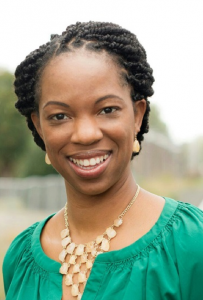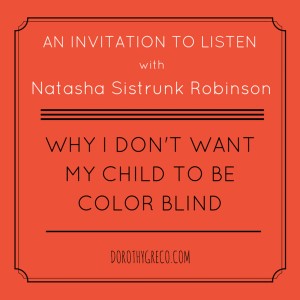 Natasha Sistrunk Robinson is an inspirational speaker, freelance writer, and human trafficking advocate. A graduate of the U.S. Naval Academy and Gordon Conwell Theological Seminary, Natasha has over 15 years of leadership and mentoring experience. She is currently authoring her first book about mentoring women.
Natasha Sistrunk Robinson is an inspirational speaker, freelance writer, and human trafficking advocate. A graduate of the U.S. Naval Academy and Gordon Conwell Theological Seminary, Natasha has over 15 years of leadership and mentoring experience. She is currently authoring her first book about mentoring women.
“I don’t see color.”
I cringe inside every time I hear these words. In most instances, people utter them in an attempt to let me and all who are listening know that they are not racist or that they value people regardless of their race. But the statement itself devalues me as a person of color, and it does not foster the racial reconciliation and healing that is currently needed within our churches and the broader culture. I’ve had several questions come to mind after hearing the “I don’t see color” statement. Questions like, “Why not? What is it exactly that you are refusing to see? How would you feel if I said that I didn’t notice the fact that you were a man or woman?”
Perhaps more important than the answers to those rhetorical questions is the reality that we do see color. We acknowledge its beauty when we select fashion patterns. Colors contribute to our enjoyment of food. Color is one of the many things that we appreciate about nature and the changing of seasons. We all see color. So if we refuse to see color when we look at the eyes, hair, and skin of another person, we are inherently acknowledging that something is wrong about our gaze.
Something is indeed wrong, but it is not the color of the other person’s skin.
Some Christians are under the false illusion that we will all just get along if we somehow ignore the issue of race. I suspect this illusion prompts well-intended white Christians to make statements like, “I don’t see color.” I suspect this illusion also leads both whites and racial/ethnic minorities to express a desire to raise “color-blind” kids. But ignoring color will not solve the race issues in America, nor will it enable the racial reconciliation that is needed in the American Church.
To read the remainder of Natasha’s fabulous article, please click this link to Amy Julia Becker’s Thin Places, at Christianity Today where the article first appeared.
Connect with Natasha through her official website, blog, Facebook, Twitter, Pinterest, or Instagram.
This is the next to the last post in my monthly series, An Invitation to Listen: African American Writers Share What It’s Like to Live in the US. Please click on Archives, 2015 to read more.

I love Natasha’s suggestions at the end of this article! I’m going to be looking into using some of the linked book suggestions in my classroom. And the reminder to embrace color is simply wonderful. In the past I’ve done some work around that with kids in my third grade class, but this year I left it out. The kids are SO happy to have each of their colors celebrated and appreciated. Sometimes it can lead to more discussion and I hope to be able to create a space where kids can really talk about these things. Lastly, the suggestion to find mentors of color is another great idea. Reading the articles from you, Dorothy, this month as well as other articles, I am beginning to find mentors of color to follow and listen to. This is SO IMPORTANT! Thank you Natasha and Dorothy!